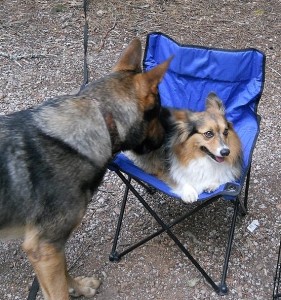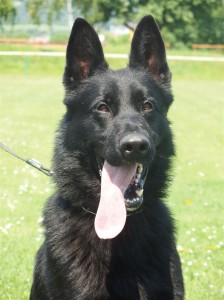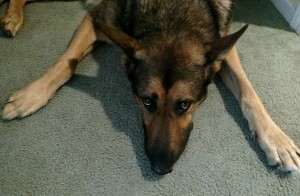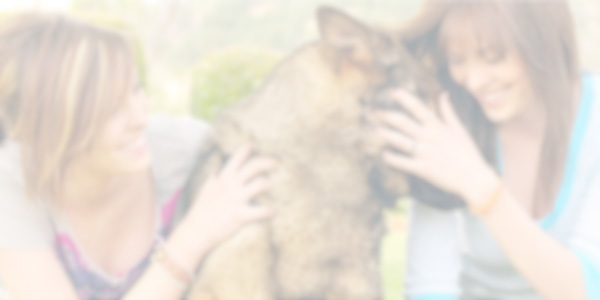The Art of Observation
 “Oh Fifi, don’t be scared of the big dog,” a woman croons as she grabs her little dog, cuddles her, and then sticks her in the face of the big German Shepherd that wanted to meet her. Fifi, now immobilized by her owner and unable to escape, is overwhelmed with fear and stress, increasing the other dog’s attraction to her. Worse still, her owner is ignoring all the non-verbal communication she is giving that shows how clearly uncomfortable she is in this situation: stiffened body, head turned to the side with ears pinned back, staring hard out of the corners of her eyes with the whites of her eyes showing, and a closed mouth with a wrinkled upper lip.
“Oh Fifi, don’t be scared of the big dog,” a woman croons as she grabs her little dog, cuddles her, and then sticks her in the face of the big German Shepherd that wanted to meet her. Fifi, now immobilized by her owner and unable to escape, is overwhelmed with fear and stress, increasing the other dog’s attraction to her. Worse still, her owner is ignoring all the non-verbal communication she is giving that shows how clearly uncomfortable she is in this situation: stiffened body, head turned to the side with ears pinned back, staring hard out of the corners of her eyes with the whites of her eyes showing, and a closed mouth with a wrinkled upper lip.
Unfortunately, this can end in only two ways. One–Fifi forces herself to endure the undignified and uncomfortable meeting, but her trust in her owner decreases and her anxiety over large dogs increases since all her warnings went unheeded. Two–Fifi erupts in a fit of snarling, snapping, and barking, potentially causing her owner to drop her or even starting a dog fight. In her panic to get out of this situation, Fifi may even inflict a few bites on her owner’s hands or on the other dog. Not only could Fifi and her owner both be hurt in this scenario, but Fifi’s trust in her handler could be completely eroded, and the “dog aggression” will be worse than it ever was.
Now imagine this big lovable German Shepherd goes home. Fifi managed to snag his ear with her sharp little teeth, but his owner doesn’t notice. The GSD is laying on his dog bed comfortably when the family’s 5-year-old boy wanders over to say ‘hi’. Normally the GSD loves “his” boy, but right now his ear stings and he’s still a little upset over his encounter with Fifi. He raises his head and stiffens his body as the boy approaches. The boy continues to come over, and sits down on the dog bed and in the dog’s space. The dog sits up with his ears back, mouth closed with tight lips, and his gaze looking out of the corner of his eyes so that the whites of his eyes show. Despite his seemingly ‘averted’ gaze, his eyes are hard and his posture has grown very still. The boy comes in and hugs the dog. The next thing the family knows, the dog snaps at the boy, catching a tooth on the top of his head and leaving a mark. The whole ugly scenario takes everyone by surprise–everyone but the dog, as he gave fair warning. Yet when the parents then take their “aggressive” dog to the animal shelter, they continue to exclaim over and over again that “He just bit our son out of the blue! We were all just sitting right there in the living room, and when our son came over, he just bit him with no warning!”
Each of these scenarios above–and many other similar scenarios involving negative dog-dog and dog-human interactions–could have been avoided had the handlers practiced the arts of observing and listening to their dogs.
Learning the Art of Observation
One of the top skills for any dog owner to learn is that of observing their dog. This is just as important for working dog handlers as it is for pet owners. This involves actively becoming a student of the dog, and looking at the way the dog physically displays his various emotions in different scenarios. What body language does the dog show when he is excited? When he is happy? When he is stressed? When he is uncomfortable? When he is upset? Below is a sampling of various body language dogs may use to communicate different moods:
 Happy – relaxed mouth and facial expressions, tail wagging in a relaxed manner, soft eye contact, ears up but mobile and not rigid (see photo at right for an example of an open and happy expression)
Happy – relaxed mouth and facial expressions, tail wagging in a relaxed manner, soft eye contact, ears up but mobile and not rigid (see photo at right for an example of an open and happy expression)
Excited – ears forward and locked into position, tail up and over the dog’s back, tail wagging tightly, higher pitched vocalizations such as high-pitched whines or barks, intense eye contact but with open facial expressions
Stressed – dog panting fairly hard even if conditions are cool, ears back, eyes averted from the stressor, head turned away from the stressor, sniffing at the ground, yawning, slowed movements, body shaking, refusal to take food
 Uncomfortable – closed mouth, licking the nose, averted or darting eyes, ears are back or out to the side, body is frozen, head is down or turned away, tail is down or clamped between the dog’s legs (see photo at left for an example of a dog expressing discomfort, coupled with a warning gaze)
Uncomfortable – closed mouth, licking the nose, averted or darting eyes, ears are back or out to the side, body is frozen, head is down or turned away, tail is down or clamped between the dog’s legs (see photo at left for an example of a dog expressing discomfort, coupled with a warning gaze)
Fearful – lowered or crouching body posture, ears pinned back, a panicked expression, hackling (hair raised on back of neck), defensive posturing such as snarling and showing teeth
Imminent aggression – completely stiff body, hard eye contact with hard facial expressions, mouth clenched tightly, lips wrinkled slightly by the nose, showing front canine teeth, the ‘whale eye’ (whites of the eye visible as dog freezes and gazes hard out of the corner of their eyes), growling (note: dogs will not show all of these signs, but if any of them are seen, the stress needs to be relieved or removed immediately!!)
Observation and Training
For working dog handlers, this art of observation continues into training, such as looking at what behaviors the dog shows when he is on the track, or has lost scent on the track, or is feeling a bit too stressed in protection work, etc. Observations are also extremely important for learning what matters to the dog. What type of play does your dog enjoy most? What types of food does he absolutely love? What toys are his favorite? When is he most active and wanting to play? The handler can take advantage of what the dog loves best and use that in their training.
The astute handler not only observes their dog’s body language, but also makes the connections between the situation and the resulting mood or emotion in their dog. Thus, their observations of their dogs should also provide insight into which types of situations the dog finds stressful, overwhelming, exciting, or uncomfortable. As a result, they are rarely “taken by surprise” by their dog’s behavior, and are proactive in heading off potentially unpleasant or dangerous situations BEFORE they occur.
Observation is just the first step. Join us next blog as we discuss the art of listening to your dog. In the meantime, get out there and become an active student of your dog and his body language!

